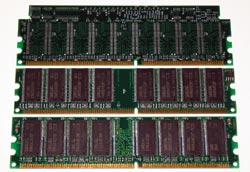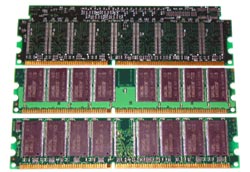Memory PCB Selection Matters
Printed Circuit Boards Impact Performance
|
|
The memory in your computer can make or break your attempts at overclocking. Recently while characterizing six low latency DDR1 PC-3200 memory kits we noticed a performance gap when overclocking the modules. Sure, it is not uncommon to experience a few MHz here and there, but we were seeing 20+ MHz differences from similar memory kits. The memory kits we have from Corsair, Kingston, Mushkin, OCZ, and PQI are pretty much identical. They all have models with identical latencies (2-2-2-5), some basic heat spreaders, Samsung TCCD IC’s and a lifetime warranty. So, memory modules using identical IC’s at identical latencies should yield similar results. We found that this was not the case and discovered a new bottleneck for memory — the PCB. Sit back and grab a drink while we reveal the bottle neck to you so the dedicated enthusiast knows what is going on.
Identical IC’s:
Once I removed the heat spreaders I found that in all 6 kits the memory modules use Samsung TCCD Revision “F” Integrated Circuits (IC’s). The full part number was K4H560838F-TCCD. All the modules used the same part number IC’s. These IC’s from Samsung are in the TSOP form factor and are rated by Samsung at 4ns. So, out of the tray, these Samsung TCCD IC’s come rated at 500MHz, with relaxed timings of 3-4-4. Sure you will find some minor differences between batches, but that is not the case today. Let’s look at the major difference for the memory kits that we used.
Different Printed Circuit Boards (PCB’s):
|
|
After taking a quick look at a couple of modules with the heat spreaders off, the differences in the PCB are very apparent. Corsair, Kingston, and Mushkin use boards that are based on the JEDEC reference design. OCZ Technologies and PQI use a different PCB made by a company called Brain Power, which is a Taiwan based corporation. Of the six kits we tested there were 3 types of PCB’s used: The reference, Brain Power’s, and Corsair’s modified reference design for use with the Pro series. The three designs are shown below so you can see the differences on both sides of the modules. We didn’t want to take the heat spreaders off of our pro modules (they are not taped) so we used one of the extra blank Corsair Pro PCB’s that we had on the shelf.
Let’s look at overclocking performance to see how these modules did.






Comments are closed.